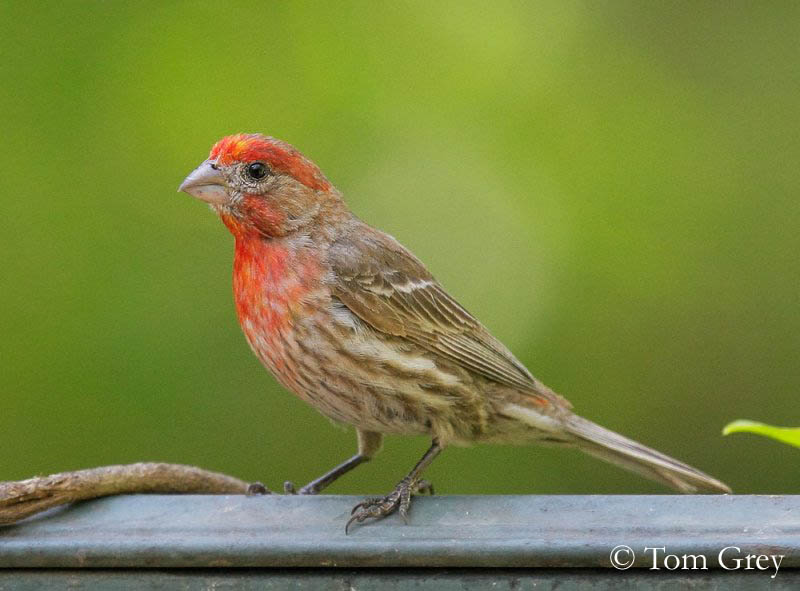
House Finch
Carpodacus mexicanus
BIOMETRICS:
Length: 13-14 cm; Wingspan : 20-25 cm; Weight: 16-27 g
LONGEVITY: up to 11 years
DESCRIPTION:

House Finch male has bright red head, forehead, eyebrow, throat, chest and rump. This colour can vary to orange or occasionally yellow. Crown, rear head and back are brown streaked with darker brown. It has brown wings and square tail. Belly and undertail coverts are white, streaked with broad brown stripes.
Eyes are black. The horn-coloured bill is short and conical. Legs and feet are dark brown.
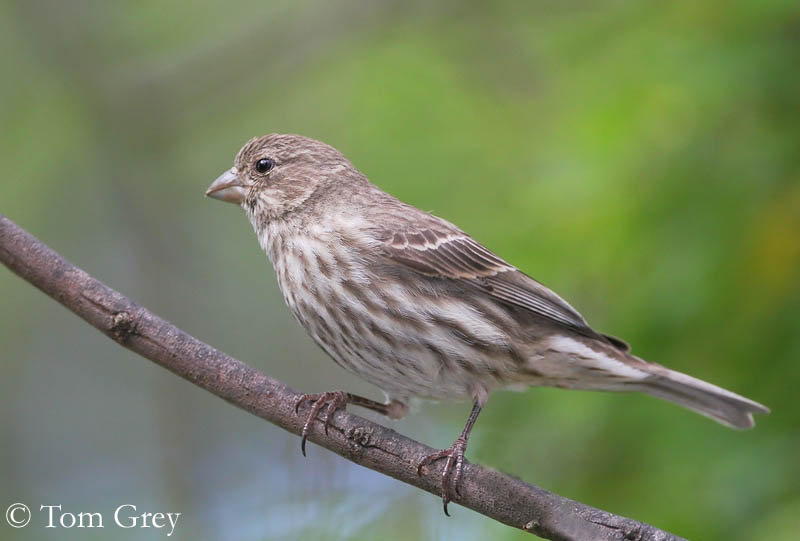
Adult female and juvenile are entirely brown, streaked dark brown, except chin, throat and breast, uniformly streaked brown on white plumage.
Female lacks red colour. Juvenile male reaches this colour by first fall.
VOICE:
House Finch’s calls include whistled “wheat” or a “weet” sound, used to contact between mates. Song consists chiefly of varied three-note phrases and includes strident notes. Song usually ends with a nasal “wheer”. It is a high pitched song.
Male sings during courtship display, at nest, during incubation and nestling period. Female sings during courtship, feeding and mating.
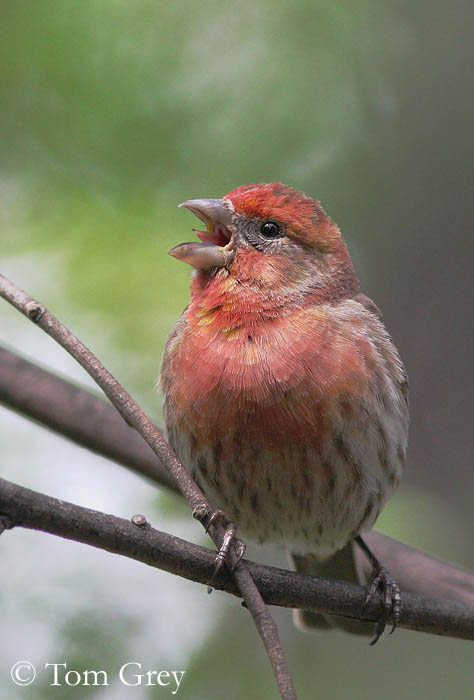
HABITAT:
House Finch lives in semi-arid lowlands and slopes up to 6000 feet. It is adapted to urban environment. We can also find it in desert grasslands, savannahs and open coniferous forests, but it requires a source of water.
RANGE:
House Finch is resident from southern Canada, southward to northern Florida and southern Mexico.
In the East, it lives in urban and suburban areas with buildings and small conifers. In West, we find it in desert, savannahs, riparian areas and open coniferous forests.
BEHAVIOUR:
House Finch forages in groups, often in trees, but also on the ground. Red colour of plumage depends of food, derived from carotenoid pigments during moulting period. Females prefer red males, because it would be able to find enough food to feed nestlings.

House Finch is active during the day. It is a gregarious bird, living in loose flocks, not territorial during breeding season, but in winter, groups may number up to 100 individuals. They roost close to each other.
During the courtship display, male sings, following the female with fluttering wings. Male ascends to 20 to 30 metres, and then, it glides to a perch singing a loud song. This display is named “butterfly flight”. It also engages courtship feeding, and it guards its mate.
In groups, House finches establish hierarchies, and females are typically dominant over males.
When House Finches are feeding in flocks, many individuals watch for predators, while the others feed.
FLIGHT:
House Finches fly in flocks. They are short distance migrants.
REPRODUCTION:
House Finch nests in bushes, thickets, natural cavities or on buildings. Nest is a well-made open cup, made of grass, leaves, rootlets, fine twigs, string, wool and feathers, and lined with the same materials but finer. Nest is built by female.
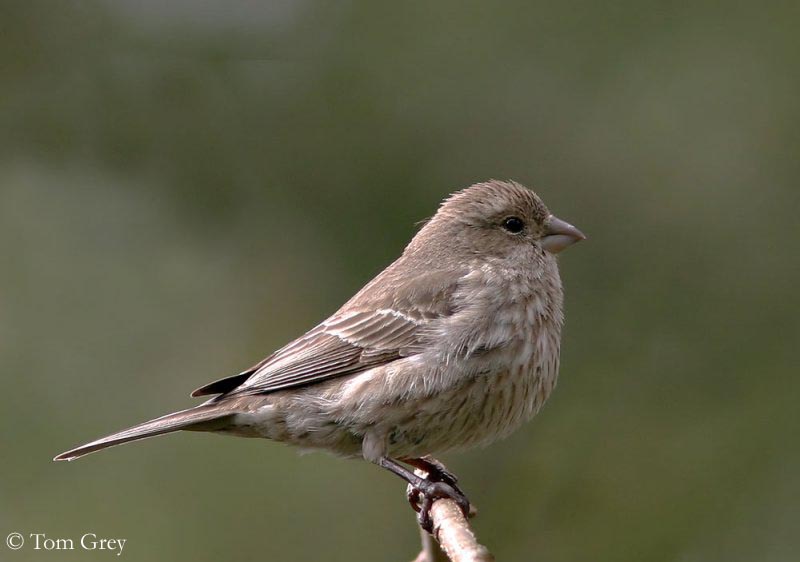
She lays 1 to 6 pale blue eggs, finely speckled with dark. Incubation lasts about 12 to 17 days, by female. She broods its altricial chicks during the first days. Both parents feed the chicks, and clean the nest, eating faecal sacs.
Chicks fledge at about 12 to 19 days, and they are fed by the male while female builds another nest for the next brood.
Young reach their sexual maturity at one year.
This species may produce six clutches per season, but only two or three will give positive results.
DIET:
House Finch feeds primarily on grains and seeds, buds and fruits. It may also eat some flowers parts and insects such as beetles larvae and plant lice. House Finch is mainly vegetarian.
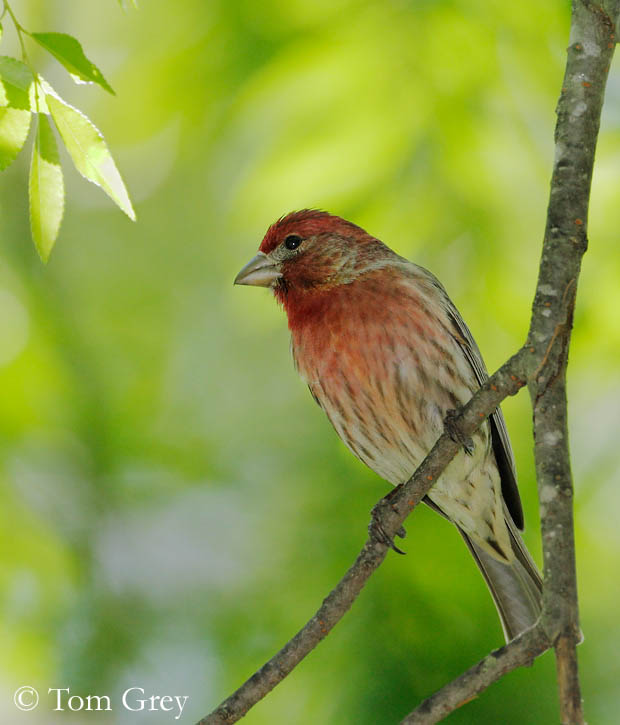
PROTECTION/THREATS/ STATUS:
Populations of House finches are increasing, and they do much economic damage to orchards, eating buds and blossoms. They feed in cultivated fields, and they become agricultural pests.
Conjunctivitis and pox infections have given some fluctuations into populations, often resulting in death.
They have nest predators such as blue jays, crows, squirrels, rats, snakes… and adults are preyed upon by cats and hawks.
Fr: Roselin familier
All : Hausgimpel
Esp : Carpodaco Común
Ital: Ciuffolotto messicano
Nd: Mexicaanse Roodmus
Sd: Husrosenfink
Photographs by Tom Grey
His website: Tom Grey's Bird Pictures
Text by Nicole Bouglouan
Sources:
FIELD GUIDE TO THE BIRDS OF NORTH AMERICA - National Geographic Society - ISBN: 0792274512
A GUIDE TO THE BIRDS OF MEXICO AND NORTHERN CENTRAL AMERICA by Steve N. G. Howell, Sophie Webb - Oxford University Press - ISBN: 0198540124
All About Birds (Cornell Lab of Ornithology)
Bird Web (Seattle Audubon Society)
What Bird-The ultimate Bird Guide (Mitchell Waite)
Wikipedia (Wikipedia, The Free Encyclopedia)